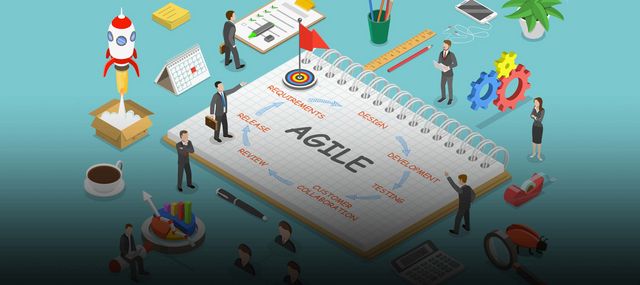24 August 2018
If you’re looking to develop innovative apps, software or digital services, you won’t get far with classic project management. The fixed milestones it uses are too rigid and inflexible. Which is why start-ups and companies are increasingly turning to agile methods - as is the Corporate Centre Innovation of TÜV NORD. #explore explains how these agile methods work and why you need defined structures and roles to free you up to develop as flexibly as possible.
Anyone planning the construction of an industrial plant is confronted with a complicated set of tasks. But if you familiarise yourself with the material with the right kind of expertise and develop a meticulous plan, it's unlikely that you will have to make any major changes before the project comes to an end. On the other hand, if you're looking to develop a completely new product, for example for lift operators, then things get complex, explains Martin Kisch from the Corporate Centre Innovation of TÜV NORD: "After all, I don't yet know the needs of the operators, they will probably change over time anyway, and I'll only be able to predict these changes to a limited extent when I start the project."
And this is where classic project management, with its planned milestones and fixed goals which have to be achieved within a particular time and brook no delay, comes up against its own limitations. If you are going to respond flexibly to new demands and customer feedback and if you want to be able to change direction even in the middle of the development process, then you need greater flexibility. It is in such cases that agile project management is proving ever more popular. In agile project management, the target is laid down in the product vision which describes the direction the development should take. Then, as things move on, the process is subjected to continuous review to decide which next step makes the most sense and will generate the greatest added value," Martin Kisch explains. So, instead of rigidly ticking off a row of previously defined checkboxes, the aim is to ensure that the tasks which are to be completed first are always the most important ones.
Agile project management also makes sense if the idea isn't to launch a completely finished product but instead to use customer feedback to develop it further. As Martin Kisch adds: “A possible service for lift operators might for example be an app which they can use to see the status of their lifts in real-time: whether they're running or not." The development team then asks what information the operators need, collates this information and develops what is known as a minimal viable product - in this case, an app which comes equipped with the envisaged basic functions. They then go back to the customers to gather their feedback. "It's incredible how much more precise people can be when it comes to saying what they need and what is helpful for them if you give them a specific application to use," says Kisch with the authority of experience. In the next step, the team then sets about incorporating the desired changes and, in the process, improving the app.
The projects in which agile methods are being used by the Corporate Centre Innovation include, for instance, a project for the online certification of individuals and the development of an Augmented Reality app for the power station sector. Martin Kisch and his team are working on a data evaluation solution to make life easier for lift operators and maintenance companies. The solution is based on Scrum, the best-known and most popular of all agile project management methods (for more information see the info box). After all, what agility definitely does not mean is innovation by happenstance and fuzzy gut instinct. "You need a relatively fixed framework within which to be agile," the innovation manager insists. Processes are also defined, and the roles and tasks to be assigned to everyone in the team are handed out. The development takes place in what are known as sprints, short units of work of no more than one month. "How long they last depends on the complexity of the task to be worked on during this period but also on the processes of the client company," Martin Kisch explains. This is because, at the end of every sprint, the result is then presented to the stakeholders, and the feedback is used to make a joint decision as to what happens next.
The "product owner" takes responsibility for ensuring the best possible output in every phase of development and the generation of the highest possible "value". This individual also maintains the product backlog, a kind of to-do list. This contains all the tasks required to achieve the product vision - the development goal being pursued. In close consultation with the stakeholders and the development team, he or she sorts the tasks in any given phase by their urgency. "If I’m going to do that to the best of my ability, I need to know a lot about the potential market and customer needs," Kisch adds. The product owner is also responsible for keeping the development team free of unnecessary work, ensuring, for example, that they are not distracted from the actual work of development by proliferating e-mail traffic with the clients.
To keep the consultation pathways short and each other up to date, Kisch and his colleagues begin every day with a "daily scrum". In this fifteen-minute team meeting, all the team members take turns to answer three questions: What did I do yesterday to move the product on? What am I doing today? What is hindering me in my work? In this way, everyone involved knows where everyone else stands. After all, the continuous improvement of the product and the team processes are of crucial importance in agile project management. Which is why Kisch and his team use what is known as a retrospective for recapitulation after every sprint: "What went well, what didn't go so well? Did we get too distracted, for example, because we were being bombarded with new requirements? What can we do to limit these?" Kisch explains. They then develop common rules to establish good processes and keep disruptions to an absolute minimum.
Since agile project management requires the team to be self organising, this means more responsibility for everyone involved. After all, you can't simply stick to a project plan; instead you have to decide yourself which steps make the most sense to move the project on. If agile project management is to work, the client companies also need to develop an understanding of the new directions that it entails, says Martin Kisch: "What we're dealing with here is a culture of mistakes. If I approach something in an agile manner, I might well find out a month later that I've been barking up the wrong tree." As far as Kisch is concerned, however, this kind of acknowledgement has nothing to do with failure: instead, it is a necessary element of the development process. "It's often impossible to know in advance whether an approach will make sense. You really have to try it out first." It's for this reason, says Kisch, that courage and the freedom to experiment are so essential. After all, in the best case scenario, it's actually those paths which appear fraught with risk which can often lead to really innovative solutions.
You may also like
So what exactly is Scrum?
Scrum is a project management method which is intended to allow a self-organised team to respond quickly and effectively to new requirements in order to develop innovative solutions. In rugby, the term denotes a set piece from which the game restarts after an infringement of the rules. In project management, the scrum is somewhat more civil and allows the team members to consult with and inform one another on a daily basis.
In Scrum there are various roles. The three most important roles are product owner, scrum master and the development team itself. The product owner’s job is to ensure that the individual tasks making up the project are sorted and prioritised by urgency and to advocate the needs and desires of the customers and stakeholders. The scrum master coordinates the team and looks after the project management by keeping the development team free of surplus work and identifying and sorting out any obstacles that may arise. And the development team itself is a heterogeneous group without any rigid hierarchical structures.
At the start of the development process, the wishes, ideas and needs of the users are identified, for instance in user stories. The next stage is to decide which are the most important and need to be implemented first. The work steps needed to do this are laid down in a product backlog, which is maintained by the Product Owner. In this document, he or she determines in consultation with the development team, the stakeholders and the customers which tasks need to be completed in line with which priority. This product backlog is continuously updated in accordance with how the development progresses. The work is done in short development cycles of up to four weeks, known as sprints. In the daily scrum, the team members update one another and consult on any issues that may arise. At the end of each sprint, the current status of the development is presented to the stakeholders - ideally in the form of a provisional product or a new feature which can be tested. In this sprint review, decisions are made jointly concerning the direction to be followed, and the steps required are worked out and then set down in the product backlog. In sprint retrospectives, the team recapitulates its work process: How can good processes be preserved by rules, and how can disruptions be avoided in the future? Alongside the constant optimisation of the product, a further aim of Scrum is the continuous improvement of the work processes.
ABOUT
© TÜV NORD
Martin Kisch is an Innovation Manager at the Corporate Centre Innovation of TÜV NORD. Here, the qualified engineer in biotechnology and process engineering concerns himself with the deployment of new technologies, for example, the potential use of data goggles in testing. He is currently dealing with the question of how digital technologies and data analysis can make the maintenance and testing of lifts more efficient.



